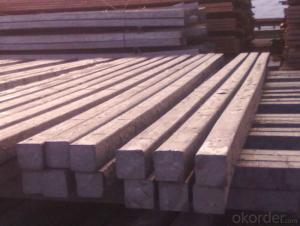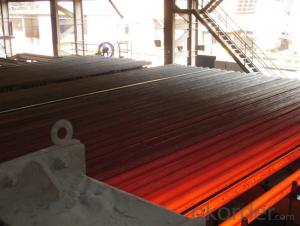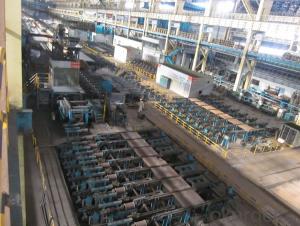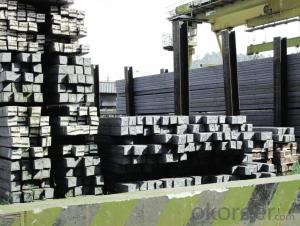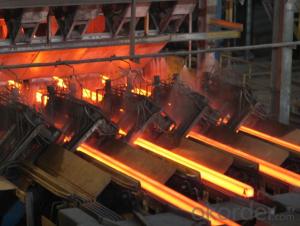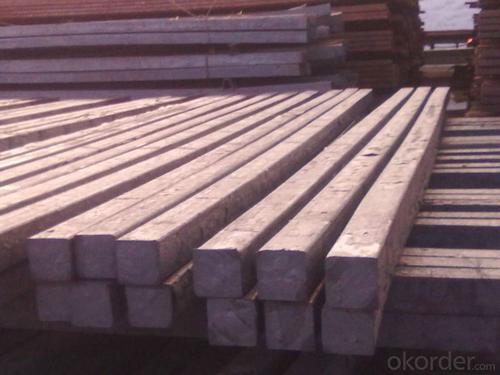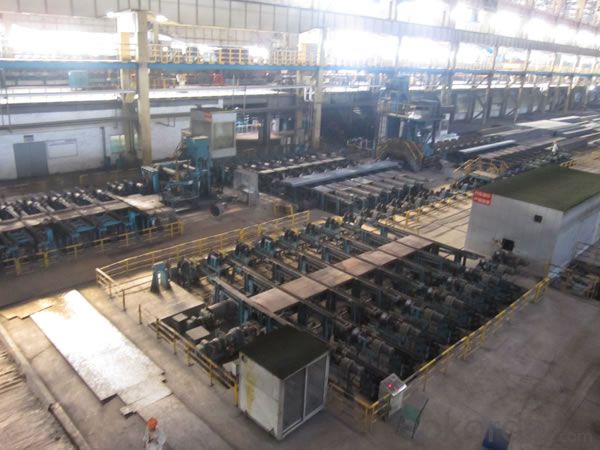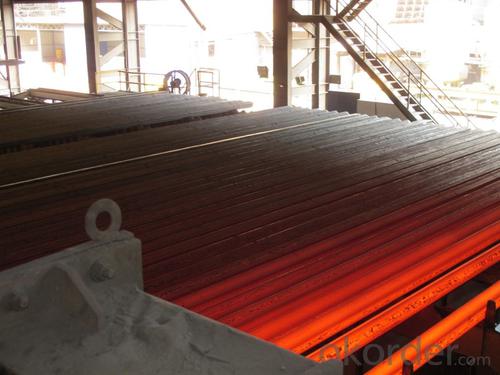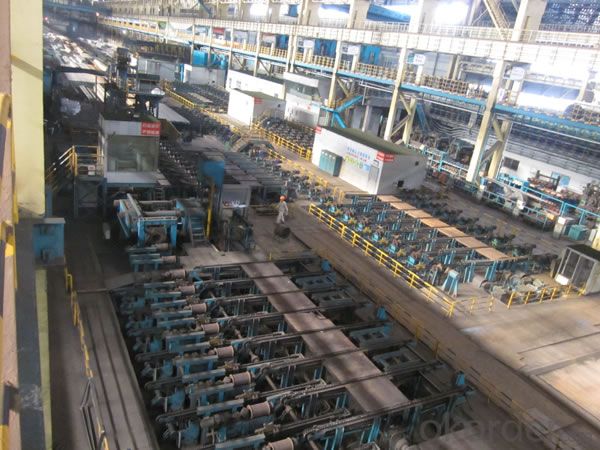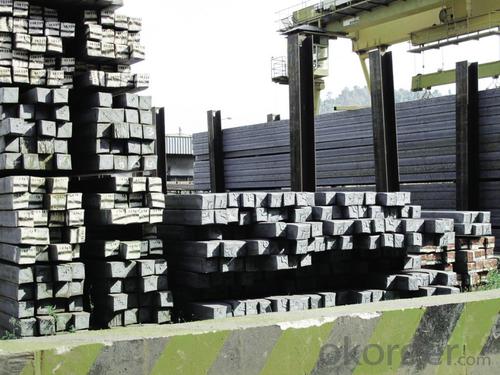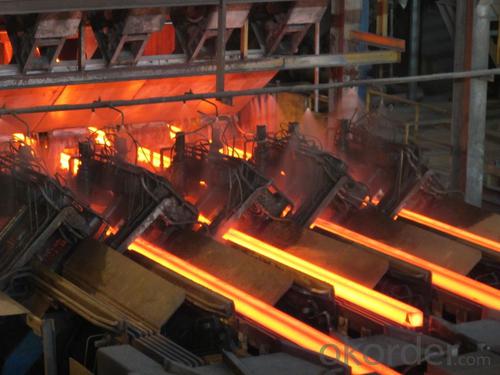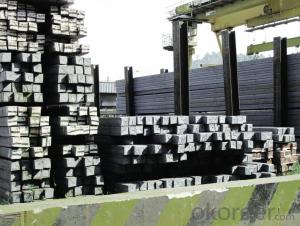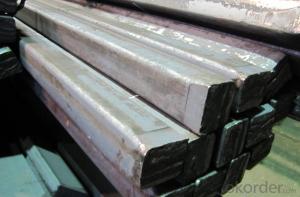Hot Rolled Steel Billet 3SP Standard 100mm
- Loading Port:
- Shanghai
- Payment Terms:
- TT OR LC
- Min Order Qty:
- 100 m.t.
- Supply Capability:
- 10000 m.t./month
OKorder Service Pledge
OKorder Financial Service
You Might Also Like
Structure of Hot Rolled Steel Billet 3SP Standard 100mm

Description of Hot Rolled Steel Billet 3SP Standard 100mm
Prepainted Rolled steel Coil is a kind of coated steel coil/sheet. With the cold rolled steel of different strength and thickness as substrate, it is produced through applying Al-Zn coat on both faces by hot dip process. In its coating, Al accounts for about 55%, Si 1.6%, while the remaining is Zn. Aluminum zinc coils enjoys both the physical protective feature and durability of Al and the electrochemical protective property of Zn. And its surface has bright silver color and regular embossed-like figure, which are highly decorative. RAL Scale Z35 Prepainted Rolled Steel Coil for Construction Roofing

Main Feature of Hot Rolled Steel Billet 3SP Standard 100mm
1.Corrosion resistance: It mainly depends on the zinc protection. When the zinc being worn,
2. Heat resistance: steel sheet has excellent heat resistance, can withstand high temperatures over 300 centigrade, and is similar with aluminized steel high temperature oxidation resistance. It often used in chimney pipes, ovens, fluorescent lighting device and the device cover.
3. Heat reflective: Galvanized steel plate heat-reflective high rate is twice as galvanized steel, often used to make insulation materials. RAL Scale Z35 Prepainted Rolled Steel Coil for Construction Roofing
Applications of Hot Rolled Steel Billet 3SP Standard 100mm
1. Construction and building: roofing; ventilating duct; handrail; partition panel;etc.
2. Electric appliance: refrigerator; washing machine; refrigerator; DVD;etc.
3.Transportation: oil tank; gas tank;road sign; etc.
4.Agriculture constructions :barn; etc.RAL Scale Z35 Prepainted Rolled Steel Coil for Construction Roofing
5.Others:vending machine; game machine; auto parts spare parts etc.
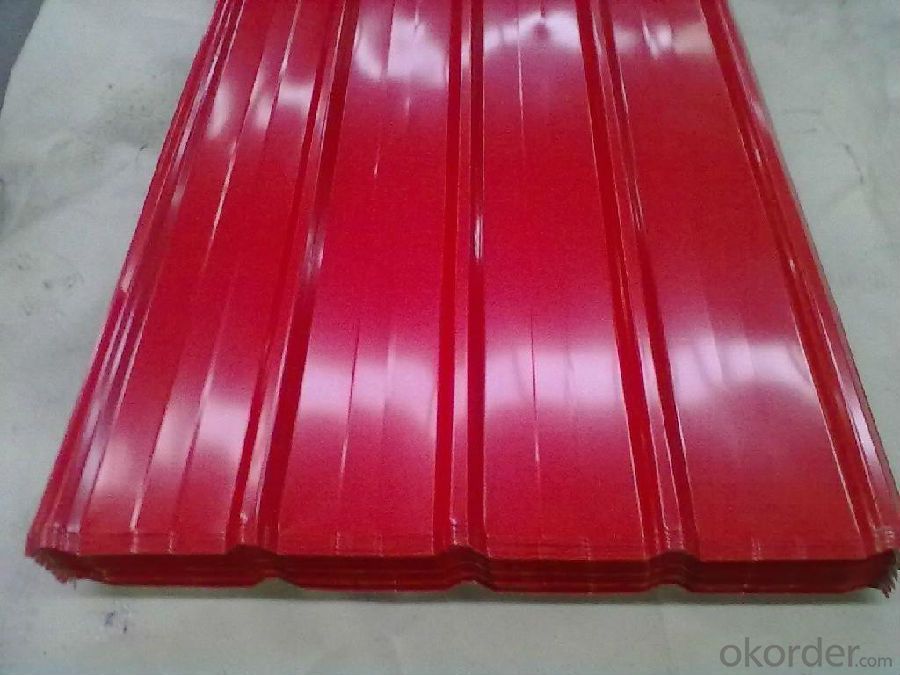
Specifications of Hot Rolled Steel Billet 3SP Standard 100mm
Product | Hot Rolled Steel Billet 3SP Standard 100mm |
Material Grade | SGCC / SGCH / DX51D+AZ, etc |
Thickness | 0.5-3.0mm |
Width | 700-1500mm |
Tolerance | Thickness: +/-0.02mm , Width:+/-2mm |
Zinc-coating | AZ30-150g/m2 |
Technique | Raw material: Hot rolled steel coil --> Cold rolled_>hot dipped galvalume |
Surface | Dried, Chromated, Unoiled,RAL Scale Z35 Prepainted Rolled Steel Coil for Construction Roofing |
Spangle | Regular spangle , small spangle, zero spangle |
ID | 508MM 610MM |
Coil weight | 25MT max |
Export package | Cardboard inner sleeves, Waterproof paper, galvanized steel covered and steel strip packed |
FAQ of Hot Rolled Steel Billet 3SP Standard 100mm
We have organized several common questions for our clients,may help you sincerely:
1. What is the minimum order quantity ?
Our MOQ is 100 mt for each size each specification. Usually we can offer discount if can buy large QTY once. RAL Scale Z35 Prepainted Rolled Steel Coil for Construction Roofing
2. How long can we receive the product after ordering?
Our general delivery time is 30 days after confirmation, but so some special orders, we have offer special delivery time
3. How to guarantee the quality of the products?
We have established the international advanced quality management system ,every link from raw material to final product we have strict quality test;We resolutely put an end to unqualified products flowing into the market. At the same time, we will provide necessary follow-up service assurance.
4. What is the payment?
We accept T/T, L/C
- Q: Are there any international standards for steel billets?
- Yes, there are international standards for steel billets. The most commonly recognized standards for steel billets include ASTM (American Society for Testing and Materials), BS (British Standards), and EN (European Standards). These standards ensure the quality, composition, and dimensions of steel billets, promoting consistency and compatibility in international trade and manufacturing processes.
- Q: What is the typical tensile strength of a steel billet?
- The typical tensile strength of a steel billet can vary depending on the specific grade and composition of the steel. However, in general, steel billets have a tensile strength ranging from 370 to 550 megapascals (MPa). This range is commonly found in low to medium carbon steels used for various applications in industries such as construction, automotive, and manufacturing. It is important to note that higher-grade steels, such as alloy steels, can have significantly higher tensile strengths, exceeding 1000 MPa. Ultimately, the tensile strength of a steel billet is determined by its intended application and the specific requirements of the project.
- Q: What are the dimensions of a typical steel billet?
- The dimensions of a typical steel billet can vary depending on its intended use and the specific manufacturing process. However, generally speaking, steel billets usually have a rectangular shape with widths ranging from 100mm to 300mm, heights ranging from 100mm to 400mm, and lengths ranging from 6m to 12m. These dimensions allow for easy handling and transportation, as well as flexibility in shaping and forming the steel billet into various end products like bars, rods, or sheets. It's worth noting that these dimensions are not set in stone and can be tailored to meet the specific requirements of the production process or the customer's preferences.
- Q: What are the main factors that affect the international trade of steel billets?
- There are several main factors that affect the international trade of steel billets. 1. Economic factors: The state of the global economy plays a crucial role in determining the demand and supply of steel billets. Economic growth and stability in major importing and exporting countries impact the overall demand for steel products, including billets. A strong economy usually leads to increased construction and infrastructure projects, which in turn boosts the demand for steel billets. 2. Government policies and regulations: Trade policies, import/export regulations, and tariffs imposed by governments significantly impact the international trade of steel billets. Governments can impose trade barriers, such as tariffs and quotas, to protect domestic steel industries or address national security concerns. These policies can directly affect the competitiveness and cost of steel billets in the international market. 3. Currency exchange rates: Exchange rates between currencies can influence the competitiveness of steel billets in international markets. If the currency of a steel billet exporting country strengthens against the currency of the importing country, it becomes more expensive for the importing country to purchase steel billets. This can impact the demand and prices of steel billets in international trade. 4. Technological advancements: Technological advancements in steel production and manufacturing processes can affect the international trade of steel billets. Improvements in production efficiency, quality control, and the development of new steel grades can give certain countries a competitive advantage in the global market. Innovative manufacturing techniques can lead to cost reductions and improved product quality, making steel billets more attractive to international buyers. 5. Environmental and sustainability considerations: Increasingly, environmental regulations and sustainability concerns are becoming important factors in international trade. Countries with stricter environmental regulations may require steel billet exporters to meet certain standards or obtain certifications, which can affect their competitiveness in the international market. Additionally, the demand for sustainable and low-carbon steel products is growing, which can influence the trade of steel billets. 6. Political stability and geopolitical factors: Political stability and geopolitical tensions can also impact the international trade of steel billets. Political instability, conflicts, or trade disputes between countries can disrupt supply chains, affect market access, and create uncertainties in the international trade of steel billets. These factors can lead to disruptions in trade flows and impact the prices and availability of steel billets in the global market. Overall, the international trade of steel billets is influenced by a combination of economic, regulatory, technological, environmental, and geopolitical factors. Understanding and monitoring these factors is crucial for stakeholders in the steel industry to navigate the complexities of the global market and make informed decisions.
- Q: How are steel billets used in the production of automotive suspension components?
- Due to their strength, durability, and malleability, steel billets play a crucial role in manufacturing automotive suspension components. Billets, which are semi-finished steel products, are shaped into specific forms like bars or rods through a process called hot rolling. When it comes to automotive suspension components, the initial step involves heating the steel billets to a high temperature. Subsequently, they are passed through a series of rollers to achieve the desired shape, such as coil springs, shock absorber rods, or stabilizer bars. This hot rolling process refines the grain structure of the steel, resulting in improved mechanical properties. The utilization of steel billets in suspension components is vital because they provide the necessary strength and stiffness to withstand the various forces and loads faced during vehicle operation. For instance, coil springs bear the weight of the vehicle and ensure a comfortable ride by absorbing impacts and vibrations. Steel billets are preferred for automotive suspension components due to their high tensile strength, which enables them to endure heavy loads and maintain their shape over extended periods. Moreover, the malleability of steel allows for easy forming and shaping into intricate geometries, ensuring precise fit and functionality within the suspension system. Furthermore, steel billets offer excellent fatigue resistance, which is crucial for suspension components as they experience repetitive loading and unloading throughout the vehicle's lifespan. This fatigue resistance helps prevent failures and ensures a suspension system that is long-lasting and dependable. In conclusion, incorporating steel billets into the production of automotive suspension components is essential for achieving the necessary strength, durability, and performance required for safe and comfortable vehicle operation.
- Q: How do steel billets contribute to the manufacturing of construction materials?
- The utilization of steel billets is crucial in the manufacturing of construction materials, playing a vital role in the industry. These billets serve as the primary raw material that undergoes transformation into a diverse range of steel products, which are then utilized in construction projects. To begin with, steel billets act as the starting point for the production of different types of steel products, including bars, rods, beams, and sections. These products are of utmost importance in the construction sector, as they provide structural support and reinforcement. For instance, steel bars are commonly employed in the construction of reinforced concrete structures, thereby imparting strength and durability to the building. Moreover, steel billets find application in the production of pipes and tubes, which hold great significance in plumbing, heating, ventilation, and air conditioning (HVAC) systems within buildings. These pipes and tubes ensure the efficient flow of water, gas, and air, thereby contributing to the overall functionality and comfort of the structure. Furthermore, steel billets are utilized in the manufacturing of steel sheets and plates, which are extensively used in construction applications such as roofing, cladding, and flooring. These steel sheets and plates offer exceptional strength, resistance to corrosion, and aesthetic appeal. They are commonly employed in high-rise buildings, warehouses, and industrial facilities. Additionally, steel billets play a crucial role in the production of prefabricated construction materials. Prefabrication involves the manufacturing of building components off-site, which are subsequently transported and assembled on-site. Steel billets are employed in the creation of prefabricated steel frames, trusses, and panels, streamlining the construction process and reducing time and labor costs. In conclusion, steel billets serve as the foundation of the construction materials industry. Their transformation into various steel products is imperative for structural support, reinforcement, plumbing, HVAC systems, roofing, cladding, flooring, and prefabrication. The utilization of steel billets ensures the strength, durability, and functionality of construction materials, making a significant contribution to the overall quality of construction projects.
- Q: What are the different types of steel billet inspection equipment?
- The manufacturing industry utilizes various types of steel billet inspection equipment to guarantee the quality and integrity of the billets before further processing. These equipment are specifically designed for this purpose. 1. High-frequency sound waves are employed by Ultrasonic Testing (UT) Equipment to detect internal flaws or defects in the steel billets. It can identify cracks, voids, and other imperfections that may impact the final product's strength and performance. 2. Magnetic Particle Inspection (MPI) Equipment utilizes a magnetic field and specially formulated particles to identify surface and near-surface defects in the steel billets. It can uncover cracks, seams, and other imperfections that may not be visible to the naked eye. 3. Eddy Current Testing (ECT) Equipment uses electromagnetic induction to identify surface cracks and defects in the steel billets. It can detect variations in electrical conductivity caused by localized defects or changes in material properties. 4. Visual Inspection Equipment makes use of magnifying glasses, microscopes, and cameras to visually examine the steel billets for surface defects, irregularities, or other visual abnormalities. This equipment is often used together with other inspection methods for a comprehensive analysis. 5. Dimensional Measurement Equipment is employed to measure the dimensional accuracy and consistency of the steel billets. It includes tools such as calipers, micrometers, and laser scanners to ensure that the billets meet the required specifications and tolerances. 6. Surface Roughness Measurement Equipment quantifies the surface finish of the steel billets. It utilizes a stylus or laser to measure surface irregularities, providing crucial information about the billet's suitability for further processing. 7. X-ray Testing Equipment uses electromagnetic radiation to penetrate the steel billets and detect internal defects such as cracks, voids, or inclusions. This method is particularly effective for larger billets or when a comprehensive assessment of the internal structure is necessary. These are some of the commonly utilized steel billet inspection equipment in the manufacturing industry. Each type of equipment plays a vital role in ensuring that the steel billets meet the required quality standards and are appropriate for further processing into various end products.
- Q: What are the potential applications of steel billets in the mining industry?
- The mining industry can benefit greatly from the versatile uses of steel billets. Firstly, these billets can be shaped and welded to create various components for mining equipment and machinery. Frames, supports, and chassis for heavy machinery can all be constructed using steel billets due to their strength and durability. This allows them to withstand the harsh conditions and heavy loads encountered in mining operations. Secondly, steel billets are ideal for fabricating conveyor belts, which are essential for transporting bulk materials in mines. The high tensile strength of steel ensures that the conveyor belts can handle the weight of the materials being transported, as well as the constant movement and impact involved in the mining process. Furthermore, steel billets can be utilized in constructing underground support systems, such as mine shafts and tunnels. These structures require reliable and robust materials to ensure the safety of workers and the integrity of the mining operation. Steel billets can be used to manufacture support beams, rods, and plates, providing the necessary stability and reinforcement. In addition, steel billets are valuable in producing wear-resistant components crucial in mineral processing, such as grinding balls and liners. These components are used in grinding mills to crush and grind ore, and steel's abrasion-resistant properties make it an ideal material for this purpose. By incorporating steel billets, mining companies can enhance the efficiency and longevity of their mineral processing operations. Overall, steel billets have a wide range of potential applications in the mining industry. From manufacturing equipment and fabricating conveyor belts to constructing underground support systems and producing wear-resistant components, steel billets contribute significantly to improving the productivity, safety, and efficiency of mining operations.
- Q: What is the typical elongation of a steel billet?
- The typical elongation of a steel billet can vary depending on several factors such as the specific grade of steel, the manufacturing process, and the intended application. However, in general, the elongation of a steel billet is typically around 20% to 30%. Elongation is a measure of a material's ability to deform or stretch before breaking. It is usually expressed as a percentage and is determined by conducting a tensile test on a sample of the material. During this test, the sample is subjected to gradually increasing tensile forces until it eventually fractures. The amount of elongation is measured by comparing the original length of the sample to its final length at the point of fracture. Steel is known for its high tensile strength, which means it can withstand significant forces without breaking. However, it also exhibits a certain degree of ductility, allowing it to elongate before reaching its breaking point. The typical elongation of a steel billet falls within the range mentioned above, indicating that it can stretch by 20% to 30% of its original length before fracturing. It's important to note that different grades of steel can have varying elongation properties. For example, higher carbon steels tend to have lower elongation values compared to low carbon or mild steels. Additionally, the manufacturing process can also affect the elongation of a steel billet. Processes such as hot rolling or cold drawing can modify the microstructure of the steel, thereby influencing its elongation characteristics. Ultimately, the specific elongation requirements for a steel billet will depend on the intended application. Certain industries, such as construction or automotive, may require steel with higher elongation values to ensure the material can withstand the stresses and strains it will encounter during use. Conversely, other applications may prioritize higher tensile strength over elongation.
- Q: What are the different types of surface finish inspection methods for steel billets?
- There are several different types of surface finish inspection methods that can be used for steel billets. These methods are crucial in determining the quality and suitability of the billets for further processing or use. Some of the common surface finish inspection methods for steel billets include: 1. Visual inspection: This is a basic method where the surface of the billet is visually examined for any irregularities, such as cracks, pits, scratches, or any other surface imperfections. It is a quick and cost-effective method but may not be able to detect subtle defects. 2. Magnetic particle inspection: This method involves magnetizing the surface of the billet and applying fine iron particles on it. Any surface cracks or defects will cause a leakage of magnetic field, attracting the iron particles and making them visible under appropriate lighting conditions. 3. Dye penetrant inspection: In this method, a liquid dye is applied to the surface of the billet. The dye penetrates into any surface cracks or defects, and after a certain period, excess dye is removed. A developer is then applied, which draws out the dye from the cracks and defects, making them visible. 4. Ultrasonic testing: This method utilizes high-frequency sound waves that are transmitted through the steel billet. The waves are reflected back when they encounter any surface irregularities, such as cracks or voids. By analyzing the time taken for the waves to return, the size and depth of the defects can be determined. 5. Eddy current testing: This non-destructive testing method uses electromagnetic induction to detect surface defects. An alternating current is passed through a coil, creating a magnetic field. When the coil is near the surface of the billet, any defects will disrupt the magnetic field, causing a change in the electrical impedance. This change is measured and analyzed to identify surface defects. Each of these inspection methods has its advantages and limitations, and the choice of method depends on the specific requirements, the size and shape of the billet, and the level of accuracy desired. By employing these surface finish inspection methods, manufacturers can ensure the quality and reliability of the steel billets before they are further processed or used in various applications.
Send your message to us
Hot Rolled Steel Billet 3SP Standard 100mm
- Loading Port:
- Shanghai
- Payment Terms:
- TT OR LC
- Min Order Qty:
- 100 m.t.
- Supply Capability:
- 10000 m.t./month
OKorder Service Pledge
OKorder Financial Service
Similar products
Hot products
Hot Searches
Related keywords
